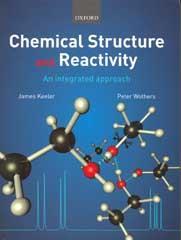Chemical structure and reactivity: an integrated approach
James Keeler and Peter Wothers
Oxford: OUP 2008 | Pp944 | £38.99 | ISBN 978-019-928-930-1
Reviewed by Jeremy Hinks

In the first book Keeler and Wothers wrote together, Why chemical reactions happen, they used, to great effect, an integrated approach to explain chemical reaction phenomena to early stage undergraduates. Their latest collaboration builds this integrated approach into a much bigger resource, a 925-page book supported by a web resource with different content for students and tutors, intended to support the early years of undergraduate learning.
The book is in three main sections. The first section covers atomic and molecular orbitals and how their energy and interaction dictate the properties of atoms, molecules and ultimately, materials. Some of the non-essential mathematics is removed in the treatment of these topics and illustrations (and web-based models) are provided to support those students whose learning develops through constructing a visual understanding of a complex theory.
The second section includes nine chapters that cover topics commonly taught in first-year courses (and often beyond). The chapter titles reveal a return to a more conventional categorisation of the chemistry covered, but in all cases the structure and reactivity of the organic and inorganic molecules, and their spectroscopic characteristics, are related back to the key learning outcomes of the integrated coverage in section one.
The book finishes with a chapter on mathematics, providing a discussion of the more complex treatments removed from the first section. The authors anticipate this will be better managed by students once they have completed the early maths modules that are now common components of chemistry degrees in the UK.
The content is carefully formulated with regard to the text and illustrations, both helping to explain some of the more challenging aspects of the topics covered in the first section of the book. Occasionally the flow of ideas is compromised by introducing exceptions or anomalies when the knowledge required to understand them has yet to be covered. The coverage in the second section is high quality too and, though the topics are separated along more traditional lines, there is a greater sense of the integration of knowledge required to gain a full understanding of undergraduate chemistry.
The objective of the authors, to break down the barriers used to manage the teaching of chemistry, is laudable, and they achieve their aim, particularly in the first section of the book. They have assembled a teaching resource that is refreshing in its style and rigorous in its content. It represents as good value as many of the similar, more traditional textbooks.
Whether there are merits in an integrated approach at the early stage of undergraduate learning over the more traditional later stage integration, once a certain level of competency has been reached, is a question that will continue to test lecturers. The outcome of this debate will decide whether this type of book joins others as an available course resource or replaces them.






No comments yet